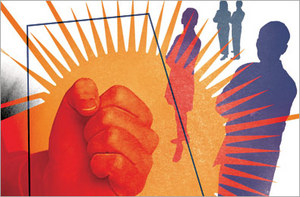
|
| ©Stuart Bradford |
An eye roll, a glare, a dismissive snort - these are the tactics of the workplace bully. They don't sound like much, but that's why they are so insidious. How do you complain to human resources that your boss is picking on you? Who cares that a co-worker won't return your phone calls?
Bullying in the workplace is surprisingly common. In a survey released last fall, 37 percent of American workers said they had experienced bullying on the job, according to the research firm Zogby International.
Unlike the playground bully, who often resorts to physical threats, the work bully sets out on a course of constant but subtle harassment. It may start with a belittling comment at a staff meeting. Later it becomes gossip to co-workers and forgetting to invite someone to an important work event. If the bully is a supervisor, victims may be stripped of critical duties, then accused of not doing their job, says Gary Namie, founder of the Workplace Bullying Institute, an advocacy group based in Bellingham, Wash.
This month, researchers at the University of Manitoba reported that the emotional toll of workplace bullying is more severe than that of sexual harassment. And in today's corporate culture, supervisors may condone bullying as part of a tough management style.
But the tide may be turning, thanks in part to a best-selling book by Robert I. Sutton, a management professor and co-director of the Center for Work, Technology and Organization at Stanford. Among other things, the book argues that workplace bullies are bad for business, because they lead to absenteeism and turnover.
The New York State Legislature is considering an antibullying bill, and in several other states, including New Jersey and Connecticut, lawmakers have introduced such measures - without success so far. A measure was withdrawn in Connecticut last week after business groups opposed it, although the bill is expected to be resubmitted.
Business groups often argue that existing laws are adequate to protect workers. But bullying generally does not involve race, age or sex, which have protected status in the courts. Instead, most workplace hostility occurs just because someone doesn't like someone else.
"Many of these situations fall between the cracks of existing state and federal employment law," said David C. Yamada, a professor at the Suffolk University Law School in Boston, who has drafted antibullying legislation. "There is a real gap in the law that someone could be tormented and subjected to humiliation and really be suffering because of it, but the courts are saying it's not severe enough for us to allow the lawsuit to go forward."
The antibullying bills are often referred to as "healthy workplace" legislation. The name is more palatable to businesses, but they also acknowledge the serious health toll bullying can have. Some victims become physically ill from the stress, with depression, anxiety and even symptoms of post-traumatic stress disorder. Surveys also suggest that victims of office bullies call in sick more often - although it's not clear whether they really are sick or just avoiding the abusive environment at work.
A surprising number of bullying cases involve health care settings, where the problem is said to be endemic, with senior hospital workers, particularly doctors and supervisors, harassing nurses and technicians. The problem is also common in academia and the legal profession, experts say.
A large share of the problem involves women victimizing women. The Zogby survey showed that 40 percent of workplace bullies are women.
This month, more than 300 readers of the Well blog posted their own stories of workplace bullies. One reader shared a story of an assistant manager who became angry with an employee. Despite his high technical skills, she cut off all contact with him.
"She gave this employee totally inappropriate assignments, setting him up to fail, and then punished him when he could not complete the assignments," said the reader, who asked not to be named. "She eventually did not invite this employee to the Christmas party." The worker finally quit.
Still, it can be hard to distinguish between normal personality disputes and the incessant torture of workplace bullying.
Researchers at the State University of New York in New Paltz have developed a survey aimed at identifying the full range of behaviors that can constitute bullying. (For a list, go here.) Some of the behaviors - glaring, failing to return calls, not praising a worker - may seem trivial, but they take a toll when repeated over and over again.
"Imagine yourself sitting at a conference table and you offer something as a suggestion and someone looks at you and shakes their head every time," said Joel H. Neuman, director of the center for applied management at the SUNY-New Paltz School of Business.
"It can be damaging to be constantly dismissed in front of your peers," Dr. Neuman said. "The thing that is upsetting about it is that people come to expect it and say, 'Well, this is what it's like around here.' It shouldn't be part of the culture, but often it is."



From my own experience (working in banks such as Mellon Bank and the Federal Reserve Bank) it seemed to me (as the rule rather then the exception) that the bank supervisors were always on the side of the workplace bully because "power attracts power." If the workplace bully could be of any advantage to the bank supervisors then they always kept him while only going thru the motions of disciplining him. Afterwards, the actions of the workplace bully would then become much more subtle, but with even greater traumatic effect on the people bullied.